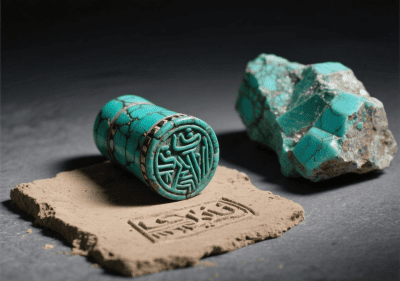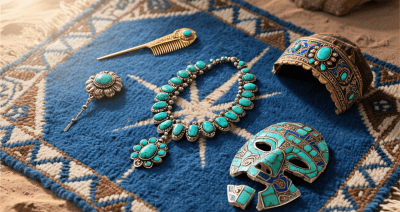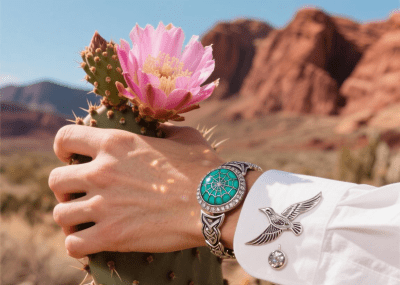The Stone That Built Empires: Why Turquoise Was Ancient Earth’s True Superpower

Description:
A highlight revealing the limits of time travel.
Left: A Persian cylinder seal carved with a winged lion, pressed into red clay—its turquoise inlay raised and glowing.
Right: A raw cluster of turquoise still embedded in its host rock, its dry matrix streaked with iron veins.
Lighting: Crossbeam museum lights emphasize the carved depth of the seal and the crystal fracture of the uncut stone.
Focus: A robin’s-egg blue bridge across millennia.
Background: Matte charcoal stone slab.
When Diamonds Meant Eternity, and Rubies Symbolized Passion, One Stone Unified Civilizations: Turquoise.
Its name means “Turkish gem,” but its legacy predates that by millennia. Why did pharaohs, shamans, and emperors covet this opaque blue-green mineral? Because turquoise wasn’t just beautiful—it was sky condensed, weaponized water, and pre-cosmic Wi-Fi rolled into one.
Archaeologists have found it in Bronze Age tombs from the Gobi Desert to Mesoamerican temples. It was humanity’s first global luxury.
Sky-Born Magic
The alchemy of turquoise begins underground—formed where surface water rich in copper seeps into stone. Its color reflects life’s essentials:
-
Blue for water
-
Green for structure
Ancient cultures saw divine fingerprints in its hue:
-
Egypt’s Living Sky:
Pharaohs called it mefkhat—“joy” and “radiance.” They set it into broad collars (wesekh), believing it carried the protection of Hathor, goddess of sky and fertility. Tomb paintings show nobles with turquoise-colored ankh—not just ornaments, but portable batteries of divine energy. -
Persia’s Celestial Shield:
Kings wore turquoise engraved with the symbol of Ahura Mazda. Warriors stitched it into armor, believing it deflected the evil eye. Its blue was not the color of invaders—but Kevlar for the spirit. -
Tibet’s Sacred Breath:
Buddhists saw turquoise’s veining as sacred rivers flowing through stone. Lamas used it to “pierce illusion.” Nomads traded sheep for beads, calling it gö—the stone of victorious life force.
Description:
A global wardrobe of turquoise tones.
Center: A Navajo silver squash blossom necklace adorned with black onyx beads.
North: A Ming dynasty Chinese gold hairpin with kingfisher feathers and domed turquoise cabochons.
East: An Ottoman gold headscarf pin, inlaid with a crescent-and-star motif.
South: Another Ming Chinese gold hairpin—identical in form, echoing from a different region.
West: An Aztec serpent-mask element—turquoise mosaic set in cedar.
Background: Handwoven indigo wool with geometric motifs.
Lighting: Soft daylight mimics desert noon, highlighting feather barbs, woodgrain, and worn textures.
Science Meets Symbol: Why Turquoise “Works”
Modern labs confirm what ancient cultures intuited:
-
Color-Light Therapy Pioneer:
Turquoise’s blue-green wavelengths (490–520 nm) have been shown to calm activity in the amygdala—the brain’s fear center. Easing anxiety isn’t magic; it’s optics. -
pH Indicator:
Turquoise subtly shifts in hue depending on skin acidity—turning greener under stress (due to increased alcohols), and bluer during calm. Unknowingly, wearers carry an ancient emotional ring. -
Copper Carrier:
Trace copper ions in turquoise may interact with the body’s electromagnetic field—perhaps explaining why healers often report a “tingling” sensation when handling it.
Description:
Desert Modernity.
A sun-kissed hand gently opens to cradle a blooming pink cactus flower.
On the wrist: a Thunderbird-patterned bracelet—oxidized silver wings clasping a premium Bisbee turquoise cabochon.
The stone’s spiderweb matrix echoes the cactus spines.
Background: A blurred red rock canyon under searing desert sunlight.
Focus: A harmony of organic beauty and mineral treasure.
Carrying Legacy: The Desert Sky Cabochon Bracelet
This piece distills 5,000 years of reverence:
-
Gemstone:
Natural Sleeping Beauty turquoise (sourced from Arizona)—a clear dye-free, resin-free stone. Its robin’s-egg blue, cloudless and luminous, was treasured by Persian kings as a symbol of eternal divine favor. -
Setting:
Hand-raised oxidized silver, featuring a Zuni thunderbird—the Native American bringer of life-giving rain. Historically, silver was believed to amplify turquoise’s protective properties. -
Intention:
Every hammer mark is embedded with blessing—an echo of the Navajo Hózhó philosophy of harmony and balance.
Why Wear This Piece of Sky?
-
Anxiety Alchemy:
Feel the cool, grounded stone press against your pulse point. In moments of overwhelm, rub its surface—a time-honored grounding technique in chaotic times. -
Conversation Catalyst:
“This blue? People once called it sky stone.”
Share the story of its journey—from Sinai mines to the Silk Road to Shangri-La. -
A Sustainable Soul:
Unlike mined diamonds, turquoise can be ethically sourced—passed down in families, and harvested with respect for sovereign lands and native stewardship. -
Its Timeless Armor:
Whether paired with denim or silk, its blue transcends trend—echoing Earth’s oldest tones: ocean and forest.
My anti-anxiety meds stay in the cabinet. My turquoise bracelet stays on my wrist. One manages symptoms. The other reminds me I belong to something ancient and eternal.
—Chloe, Colorado



I bought the Desert Sky bracelet during a brutal work crunch, skeptical about “healing stones.” But pressing that Sleeping Beauty turquoise cabochon to my pulse point during panic attacks? Instant calm. My therapist confirmed it: the blue-green wavelength literally slows fight-or-flight responses. Now I watch it shift hues—bluer on yoga mornings, greener during deadline stress—like an emotional weathervane on my wrist.
The real magic unfolded at a Navajo jewelry exhibit. When I showed an elder the thunderbird motif, her eyes lit up: “That’s Tó Neinilii, bringer of rain!” She traced the spiderweb matrix, whispering how her grandfather mined Bisbee stones. Suddenly, this wasn’t just jewelry; it was a living artifact connecting me to sovereign lands and stories older than empires.
Wearing it feels like carrying compressed sky. The oxidized silver clasp (hand-raised with intentional hammer marks) develops a charcoal patina that contrasts beautifully with denim jackets, while the robin’s-egg blue stone pops against summer whites. During my Iceland trip, glacier guides mistook it for Arctic ice—until desert sunlight revealed its true Arizona soul.
Chloe from the blog nailed it: this stone anchors me to something eternal. When modern life overwhelms, I rub its cool surface and remember—I’m wearing the earth’s first global love language.